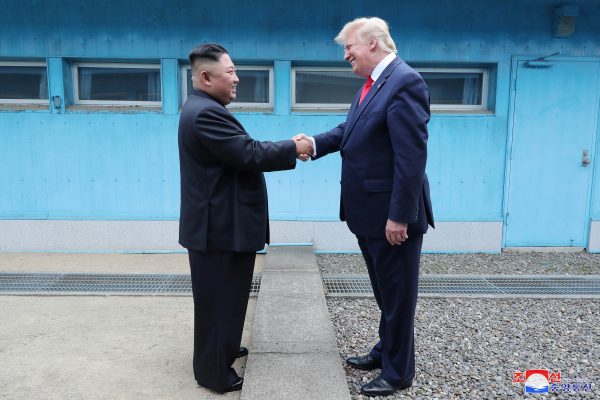There was a dramatic reversal in 2018. The Pyeongchang Winter Olympics in February led to a series of summits — the Panmunjom summit in April, the first North Korea–US summit in Singapore in June and the Pyongyang summit in September. All three summits underscored an improvement of inter-Korean relations, commitment to a lasting peace regime and pledges to complete denuclearisation of the Korean Peninsula. Most Koreans strongly believed that peace was near.
This optimism was shattered when the Hanoi summit between North Korean Chairman Kim Jong-un and US President Donald Trump in February 2019 failed to produce any tangible outcome. In Hanoi, the United States proposed a deal under which North Korea would first dismantle nuclear and bio-chemical weapons and missiles. In return the United States promised a bright future for the North Korean economy.
But North Korea rejected the offer, instead adhering to the principle of incremental simultaneous exchange framed around ‘action for action’. It counter-offered the final and complete dismantling of all nuclear facilities in Yongbyon while demanding the partial relaxation of five UN Security Council sanctions that have affected its civilian economy since 2016. North Korea’s proposal was concrete, and it was desperate to make a deal. But the gap between the two sides was huge, and the summit broke down. Pyongyang suffered much from the Hanoi trauma, which severely strained both US–North Korean and inter-Korean relations.
A surprising Trump–Kim meeting in Panmunjom in June 2019 opened another window of opportunity. US–North Korea working-level talks were held in Stockholm in October, but assessments of the talks contrasted. North Korean representative Kim Myong-gil declared that the talks failed because the United States came without a new approach and it would be ‘sickening’ to have further discussions. The United States refuted this in a press release, stating that it had ‘brought creative ideas and had good discussions’. The United States also accepted an invitation from the Swedish government to attend another round of talks with North Korea.
What went wrong in Stockholm? There may have been a hostile protocol gesture by North Korea. Trump’s earlier rejection of Kim’s proposal on the Yongbyon deal and abruptly cancelling the planned luncheon in Hanoi was a great insult to North Korea’s supreme leader. A retaliatory gesture might have been calculated to repay the Hanoi humiliation. Such protocol retaliation is not uncommon in Pyongyang’s diplomatic behaviour.
The scope of denuclearisation must have been another contentious issue. According to several reliable sources, including a Yomiuri Shimbun report, the United States demanded North Korea’s commitment to transfer all nuclear weapons, materials and ICBMs to the United States and dismantle all facilities related to the production of nuclear or biochemical weapons and ballistic missiles. Complete dismantling of all nuclear facilities in Yongbyon, declaration of and commitment to the elimination of clandestine nuclear facilities elsewhere and freezing all nuclear activities were also required. Such demands were unacceptable to North Korea. At most, Pyongyang could have counter-offered the Yongbyon card raised at the Hanoi summit.
Divergent expectations on corresponding measures were also a source of friction. The United States reportedly offered temporary relief from the export ban on coal and textiles, resumption of humanitarian assistance and the adoption of a declaration to end the Korean War. It was also rumoured that the United States showed a blueprint for the development of Galma tourist complex — Kim’s signature project — with a plan to mobilise international capital. Pyongyang rejected them outright by arguing that the United States had not yet even reciprocated North Korea’s goodwill efforts such as a freeze on nuclear and ICBM tests since 2018.
North Korea announced in October 2019 that it was not interested in returning to the negotiating table unless ‘the United States takes substantial steps to make complete and irreversible withdrawal of the hostile policy’. Pyongyang does not want small concessions, but a major one involving the end of enmity through diplomatic normalisation and lifting sanctions.
The gap between Pyongyang and Washington is huge. Both states need to change the negotiation pattern of ‘giving less and taking more’ to reach a compromise.
Trust-building seems most essential in this regard. Trust can be built only on the basis of success stories, no matter how small they are. Pyongyang can invite international inspectors to the demolished Punggye-ri test site, dismantle the missile engine test facility and launching pad in Tongchang-ri, eliminate all nuclear facilities in Yongbyon, and declare and commit to dismantle additional hidden nuclear facilities. The United States should reciprocate by offering an exchange of liaison offices, suspension of joint military exercises, peace accord negotiations and a partial relaxation of existing sanctions — including the reopening of the Kaesong Industrial Complex and the Mount Kumgang tourist project.
Only then can a comprehensive agreement on complete and verifiable denuclearisation in exchange for complete and irreversible withdrawal of hostile policies be reached, along with a concrete roadmap and timetable. The rhetoric of promising ‘a brighter future for the North Korean economy’ cannot move Pyongyang. Security assurances such as diplomatic normalisation and non-aggression treaties should be presented first, rather than at the end of negotiations. And it seems highly unlikely that North Korea will make any significant concessions without corresponding measures on sanctions relief.
Reaching such compromise will not be easy amid Trump’s impending impeachment process and Kim’s immense domestic disappointment. But the strong political will of both leaders is cause for optimism.
Chung-in Moon is Distinguished University Professor, Yonsei University and Vice Chairman and Executive Director, Asia-Pacific Leadership Network for Nuclear Non-proliferation and Disarmament.
This article appears in the most recent edition of East Asia Forum Quarterly, ‘Economics and security’, Vol. 11 No. 4.

